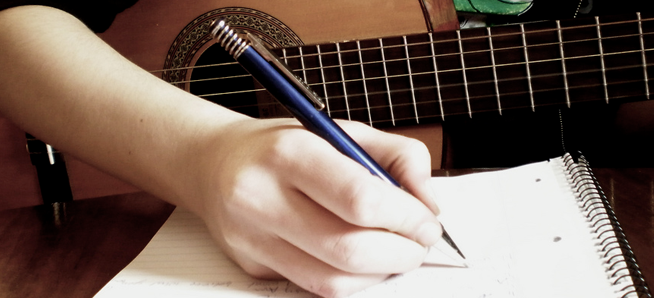How To Write Blues Lyrics: Writing blues lyrics is an art form that gets to the heart of what it means to be human by expressing raw emotions like happiness, sadness, and everything in between. The blues have their roots in African American history. They have grown into a style of music that uses a unique beat and honest storytelling to show the ups and downs of life.
When you start writing blues lyrics, you enter a world where honesty is the most important thing. The blues, which grew out of the problems and successes of communities, are a special way to talk about feelings in a way that is healing and meaningful. Blues lyrics, whether they’re sung with the sad scream of a guitar or the soul-stirring rasp of a singer, can be a powerful way to express yourself.
For this study, we will look at what makes blues lyrics unique: the painful themes, vivid imagery, and rhythmic patterns that give the genre its unique cadence. We’ll look at how blues legends tell stories and find the universal truths that make blues lyrics timeless. Let’s take a trip into the heart of the blues, where words become a symphony of what it’s like to be human.

What is the formula for the blues song?
The lyrics of a 12-bar blues song often follow what’s known as an AAB pattern. “A” refers to the first and second four-bar verse, and “B” is the third four-bar verse. In a 12-bar blues, the first and second lines are repeated, and the third line is a response to them—often with a twist.
A blues song has a specific structure and themes that have been used to define the style for a long time. At its core, a blues song is a true account of what it’s like to be human, often based on hardship, pain, or strength. A 12-bar pattern is used as the basic structure for most blues songs. It’s what makes the passionate stories in the genre possible.
The blues progression is made up of three phrases of four bars, each playing over and over again in a dynamic way. Each bar often corresponds to a musical measure and gives the blues artist a chance to show how they feel. The soulful roots of blues music can be heard in the lyrics, which often talk about things like lost love, hardships, or personal reflection.
In this structure, blues musicians use call-and-response patterns that let the singer’s expressive voice connect with the instrumental backing. It’s not just about the structure of the music; the blues formula is about showing what it’s like to be human through vivid stories and melodic resonance. As musicians play the 12-bar blues, they use personal experiences in the lyrics, which builds a connection between the performer and the audience that lasts forever. A blues song is almost impossible to write down in music notation; it’s a powerful mix of emotion, rhythm, and storytelling that speaks to people of all ages.
What are the key elements to consider when crafting authentic and expressive blues lyrics?
To write honest and passionate blues lyrics, you need to know a lot about the history of the style and be interested in exploring the raw and emotional sides of life. Take a look at these important factors:
Emotional Authenticity: The blues lyrics are based on strong feelings. Authenticity is very important, and songwriters should use their struggles and successes to show how they really feel. Being honest with others helps you connect with them and build a relationship.
Blues music is a type of story music. Effective blues lyrics often tell a story, whether it’s about love, loss, pain, or strength. A well-written story keeps people interested and makes the music more relatable.
Blues songs often use vivid imagery and metaphors to talk about how they feel and what they’ve been through. Strong visual elements make it easier for people to connect with the song, which makes it easier to remember and more interesting.
Knowing about common blues themes like love gone wrong, betrayal, or the problems people face in their daily lives lets songwriters use these ideas in their unique ways.
Poetic language, like rhythm, rhyme, and clever wordplay, works well in blues lyrics. This gives the lyrics a musical element that helps you remember them and adds to the mood of the song as a whole.
Think about the things that make blues music unique, like the 12-bar blues progression, soulful melodies, and expressive instrumentation, by matching the words to these musical styles, a unified and real blues experience is made.
Writers of blues music can use these elements to create lyrics that are moving, tell interesting stories, and truly capture the essence of the blues style.
How are blues songs composed?
In a blues song with a sung text, the lyrics consist of a line that is repeated, then followed by a contrasting line (aab). The melody often follows this structure as well. Blues melodies often leave large gaps to allow for call-and-response between the melodic instrument and other instruments.
To get to the heart of what it means to be human, blues songs are written with a unique mix of emotion, story, and music. Usually, the blues artist starts by thinking about things that have happened to them or things that affect everyone, like love, loss, hardship, or strength. These thoughts form the basis of the song’s lyrics and show how raw and honest blues storytelling is.
Many blues songs are built around a 12-bar pattern, which shows how the song builds from one part to the next. This pattern is used as a base for arranging chords and making a background that is both repetitive and changing for the story. Blues musicians often use traditional instruments like guitars, harmonicas, and keyboards to add soulful melodies and expressive solos to their songs.
The artist’s vocal delivery adds to the composition of blues songs. The singer’s voice has a distinct timbre, phrasing, and emotional nuances that contribute to the overall effect of the song. Improvisation is also an important component, allowing musicians to express themselves freely within the predetermined structure, giving each performance spontaneity and personality.
Finally, blues songwriting is a highly personal and intuitive process in which the artist’s sincerity and connection to the material play a significant role in creating a strong and resonant musical experience.

What is the structure of the blues music?
The 12-bar blues. sequence is the most used chord progression in blues music. The sequence orientates around the tonic, subdominant and dominant chords of the key signature close key signatureA pattern of sharps or flats at the beginning of a piece of music indicating which are to be played.
Blues music is distinguished by a distinct structure that has become synonymous with the genre. The traditional blues structure is based on a 12-bar pattern, which serves as a framework for both the melodic and lyrical components of the song. This arrangement, also known as the 12-bar blues progression, serves as the foundation for countless blues pieces.
The 12-bar blues progression is made up of three four-bar phrases that provide a repetitive yet emotional sequence. In musical notation, each of these bars corresponds to a measure. The first four bars frequently establish the primary chord, the following four bars provide a shift, and the final four bars resolve the musical tension, resulting in a pleasant and cyclical rhythm.
Blues musicians typically use a call-and-response approach within this framework, in which a lyrical or musical line is offered and answered by another, creating a dynamic interplay between voices and instruments. This framework not only provides a recognizable foundation for the music but also allows for improvisation, which is essential in blues performances.
Blues music’s framework is not rigidly established; instead, it serves as a flexible template that encourages innovation and personal expression. This fundamental 12-bar form, along with its variations, has contributed to the long-lasting and diverse quality of blues music across numerous styles and generations.
In what ways can a songwriter incorporate personal experiences and emotions into their blues lyrics for added authenticity?
Personal experiences and emotions must be incorporated into blues lyrics in order to establish an honest and meaningful connection with the listener. Here’s how a songwriter can do it:
Draw on Real Life Experiences: Authenticity begins with genuine feelings. Songwriters should consider their own life experiences, relationships, trials, and triumphs. They imbue the songs with sincerity by delving into actual human stories.
Blues is a genre that thrives on genuine emotions, so express your vulnerability. Songwriters can increase their authenticity by depicting vulnerability in their lyrics. Sharing experiences of sadness, loss, or personal adversity allows listeners to connect on a deeper level.
Using personal words, such as “I,” “me,” or “my,” creates a direct and intimate connection between the songwriter and the audience. This personal touch contributes to the expression of the unique aspects of the experiences being recounted.
Explore Emotional Depth: Instead of avoiding overwhelming emotions, songwriters should delve deep into the well of feelings. Whether it’s the agony of a breakup or the joy of triumphing over adversity, developing emotional depth enriches the lyrical material.
Capture Unique Moments: Rather than generalizing experiences, concentrate on capturing unique moments or details. Actual settings, conversations, or sentiments are described in order for listeners to visualize the songwriter’s narrative.
Cultural Influences: Cultural influences typically have an impact on personal experiences. Songwriters may infuse cultural references, customs, or regional characteristics into their blues lyrics, resulting in a distinct and personal storytelling style.
Accepting these strategies allows songwriters to honestly transfer their personal experiences and feelings into blues lyrics, establishing a genuine connection with listeners who may find solace, understanding, or shared sentiments in the music.
What makes a blue song?
The blues has a distinct melancholic and somber tone, which is achieved through vocal techniques such as melisma, rhythmic techniques such as syncopation, and instrumental techniques such as “choking” guitar strings on the neck or applying a metal slide to the guitar strings to create a whining voicelike sound.
A blues song is distinguished by its distinct combination of musical elements and emotional expression, capturing the essence of the human experience through storytelling and unusual musicianship. Several important characteristics contribute to the definition of a blues song:
Most blues songs follow the 12-bar blues progression, a fundamental musical structure consisting of three four-bar phrases. This pattern provides a distinct framework for the music.
Blues lyrics frequently explore themes of struggle, love, loss, and resilience. The story is honest, genuine, and emotionally charged, reflecting the artist’s personal experiences or universal difficulties.
Soulful Melodies: Soulful melodies are featured in blues music, which is performed on traditional instruments such as guitars, harmonicas, and keyboards. These instruments contribute to the distinct sound of the genre, which is defined by bends, slides, and vibrant solos.
Many blues songs use a call-and-response pattern, in which a comparable response follows a vocal or instrumental statement. This interaction gives the music a dynamic and compelling personality.
Improvisation: Blues musicians frequently engage in improvisation, which allows for spontaneity and personal expression within the confines of the set structure. This element of spontaneity contributes to the live and dynamic nature of blues concerts.
Blues singers often have a distinct vocal style defined by expressive phrasing, soulful delivery, and a raw, gritty sound that adds depth and authenticity to the song.
A blues song is a powerful and evocative musical form that connects with listeners on a visceral level, depicting the highs and lows of the human experience with honesty and passion.
How To Write Blues Lyrics
Writing blues lyrics requires a deep connection to the emotions and experiences that define the genre. To begin, learn about the rich history of blues, from its origins in African-American culture to its transformation into a powerful expression of life’s trials and triumphs.
Begin by accepting the blues framework, which is commonly represented by a 12-bar pattern. Create a memorable, repeating melody, which is an essential component of blues music. When writing songs, draw inspiration from your struggles, heartbreaks, and experiences. Because the blues are a storytelling genre, use realistic and vivid vocabulary to communicate your story.
Consider combining traditional blues themes such as love, sorrow, adversity, and salvation. To emphasize different emotions, use repetition and metaphorical language. Blues music necessitates authenticity, so let your voice shine through and convey the true, unadulterated nature of your feelings.
To enhance your lyrics:
Use the guitar and harmonica, two classic blues instruments.
Feel free to experiment with different chord progressions to elicit the desired feelings.
Remember that the blues is a genre that values individual expression, so let your point of view and life experiences shine through in your lyrics.
How to Write a Blues Song: The Ultimate Guide
Composing a blues song is an enthralling experience that requires both a genuine emotional connection and a thorough understanding of the genre’s history. Begin by immersing yourself in timeless tunes to understand the distinct structure and feel of blues music. The 12-bar blues pattern is a fundamental element that serves as a solid foundation.
A true blues song should be inspired by the author’s life experiences, trials, and triumphs. Because blues music is known for its storytelling, it creates a story that touches on universal themes such as love, grief, and resiliency. To convey the essence of the human experience, use honest, expressive language in your songs.
Use repetition and metaphorical language to emphasize emotions. Blues lyrics frequently use a call-and-response structure, which allows for a dynamic narrative. To enhance your poetic story, use traditional blues instruments such as the harmonica and guitar.
Bring in your voice and point of view to promote authenticity. Because the blues is a genre that encourages personal expression, don’t be afraid to incorporate elements of your own life story into the lyrics. Accept blues music’s soulful rhythms and melodies, and then let your imagination run wild to write a blues song that speaks to both innovation and heritage.

Writing blues lyrics is more than just putting pen to paper; it is about expressing real feelings and experiences through a melodic story that speaks to the soul. The blues genre, with its sincerity and unadulterated expression, provides a forum for songwriters to share their most intimate thoughts and establish a strong emotional connection with listeners.
Good blues lyrics embrace both our life’s setbacks and victories, capturing the essence of the human experience. By using personal language, conveying vulnerability, and drawing from real experiences, songwriters are able to weave a potent emotional tapestry that goes straight to the hearts of listeners.
Blues lyrics are about expressing emotional depth, encapsulating specific events, and acknowledging cultural influences, among other things. This genre values individual stories while drawing on universal themes that unite us all through our shared humanity.
In the blues world, authenticity is the currency that fosters a genuine relationship between the performer and the audience. Through the passionate presentation of personal stories and feelings, blues lyrics become a timeless and relevant accompaniment to the varied journey of life. Artists discover a profound form of communication that cuts through time and connects with listeners of all ages while navigating the blues, in addition to a musical outlet.







Leave a comment